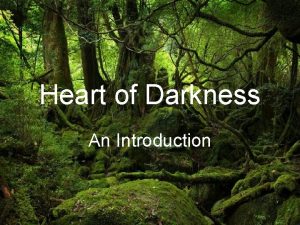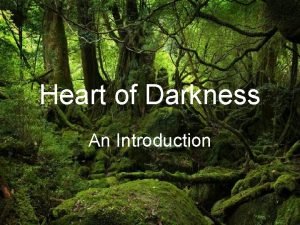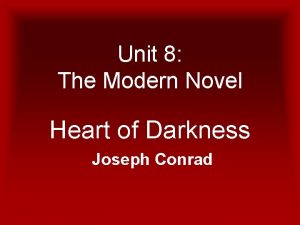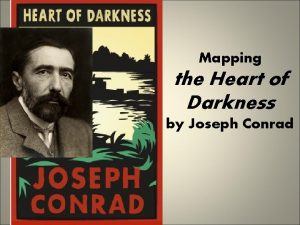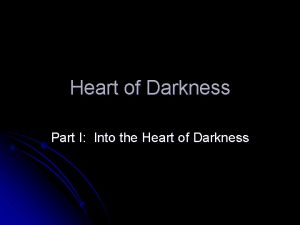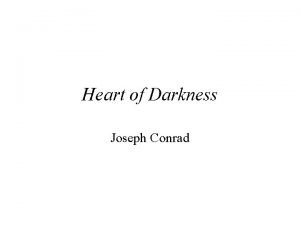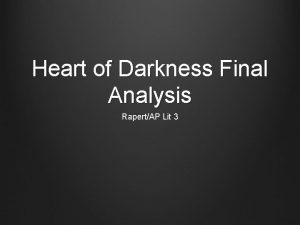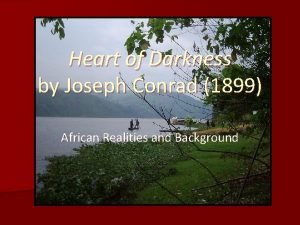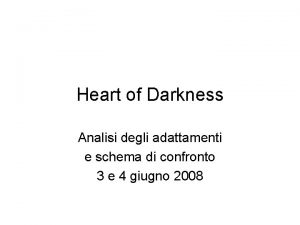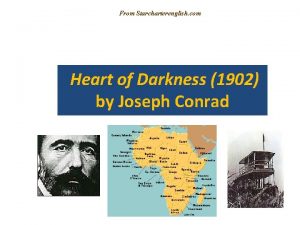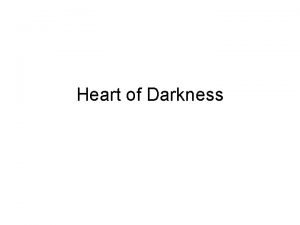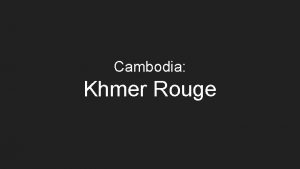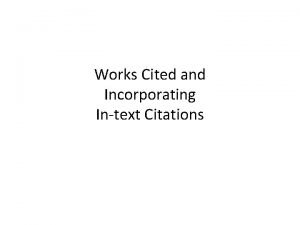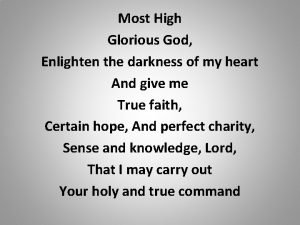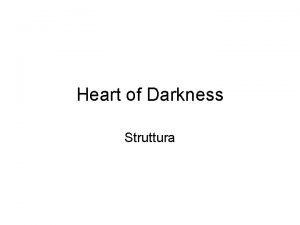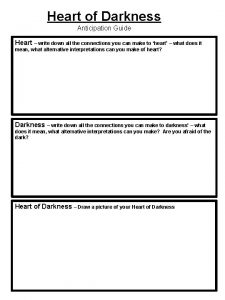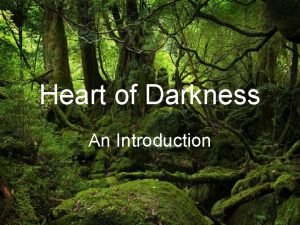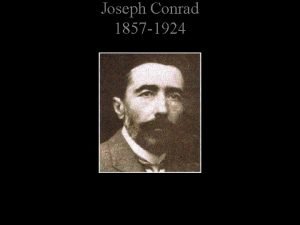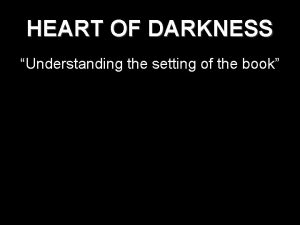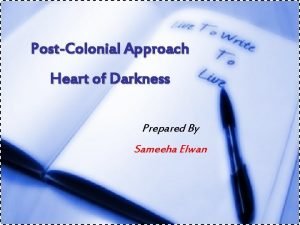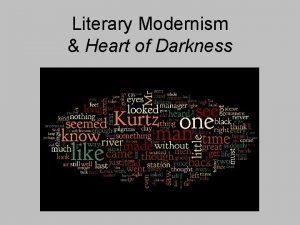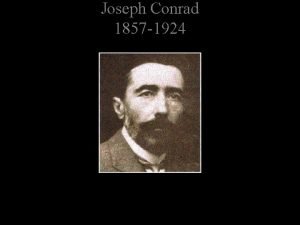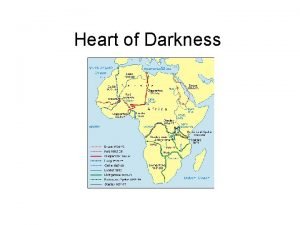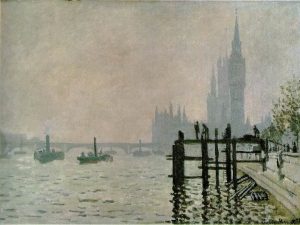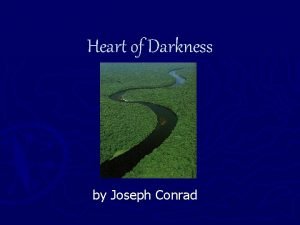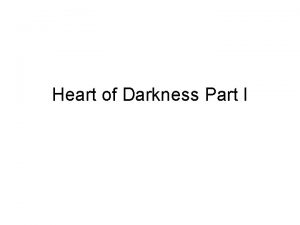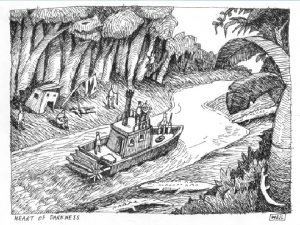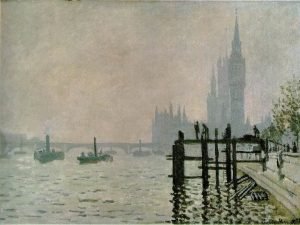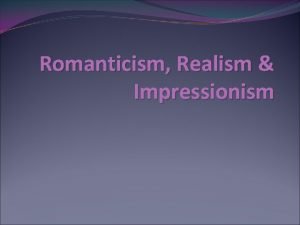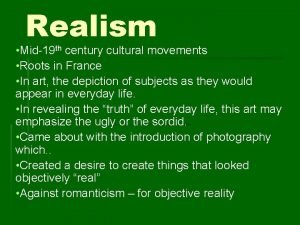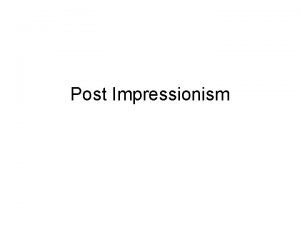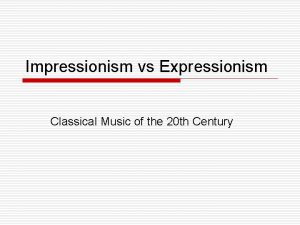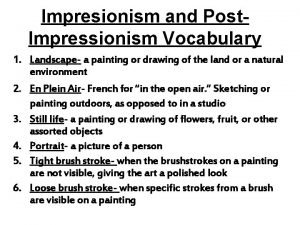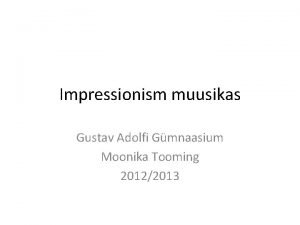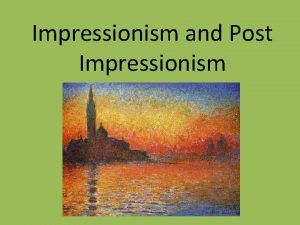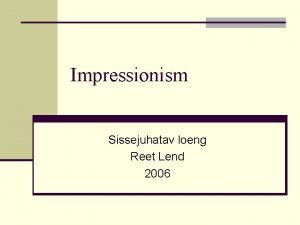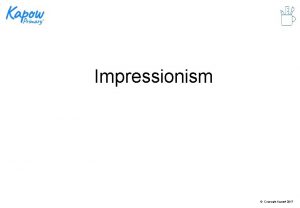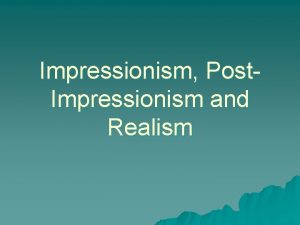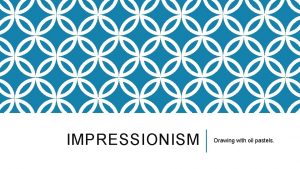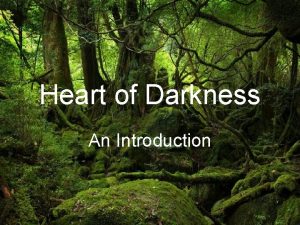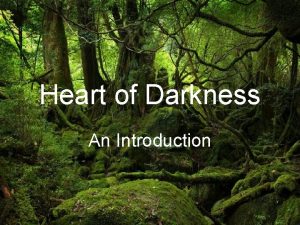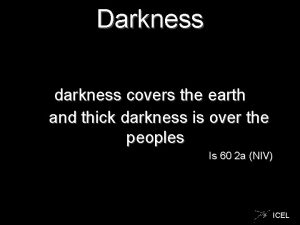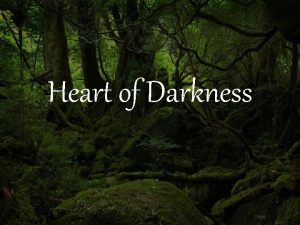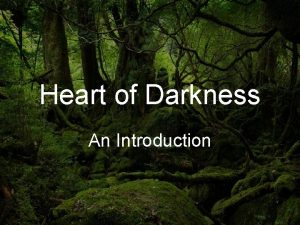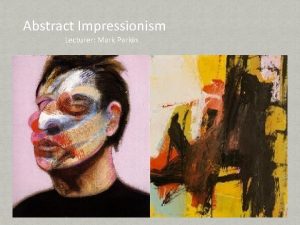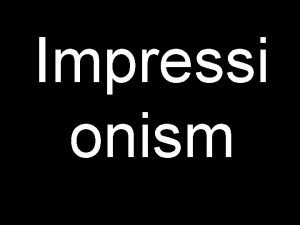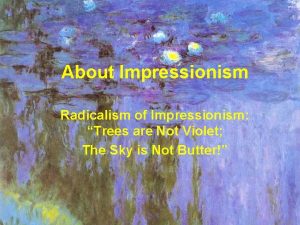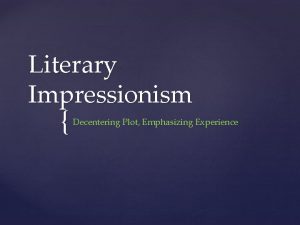Heart of Darkness An Introduction Impressionism Why the

















































- Slides: 49

Heart of Darkness An Introduction

Impressionism



Why the Blurriness? • For modern novelists, the messiness and confusion and darkness of experience is interesting. • Rather than trying to simplify and abstract a particular meaning from experience, novelists tend to celebrate the multiplicity of ideas and meanings and sensations that experience can provide.

Why the Blurriness? • Modern novelists are in the business of recreating and communicating the rich complexities of the experience itself. • Their purpose is to get the reader to re-live an experience, with all its complexity and messiness, all its darkness and ambiguity.

Topics • • • Conrad’s World View About the Novel / Modernism Key Facts & Historical Context Narrative Style Interpretation

Conrad’s World View • For Conrad, the world as we experience it is not a place that can be reduced to a set of clear, explicit truths • Instead, its truths (of the psyche, of the human mind and soul) are messy, vague, irrational, suggestive, and dark. • Conrad’s intention is to lead his readers to an experience of the “heart of darkness. ” • His goal is not to shed the light of reason on it, but to recreate his experience of darkness in our feelings, our sensibilities, our own dark and mysterious hearts.

About the Novel • Since its publication, Heart of Darkness has fascinated readers and critics, almost all of whom regard the novel as significant because of its use of ambiguity and (in Conrad's own words) "foggishness" to dramatize Marlow's perceptions of the horrors he encounters. • Critics have regarded Heart of Darkness as a work that in several important ways broke many narrative conventions and brought the English novel into the twentieth century.

What is Modernism? • Criticized the 19 th century as a dangerously unreal period of comfortable certainty and positive assurance • Broke up the logically developing plot typical of 19 th century novel • Attempted to use language in a new way • Drew attention to style instead of trying to make it “transparent”

What is Modernism? • Offered unexpected connections or sudden changes in perspective • Played with shifting and contradictory appearances to suggest the shifting and uncertain nature of reality • Used interior monologues and free association to express the rhythm of consciousness • Blended fantasy with reality while representing real historical or psychological dilemmas

What is Modernism? • Modernism claims to show: – a more accurate representation of reality – a better understanding of human consciousness • The 20 th century “vision” places its emphasis on how we know – on the structures of perception themselves – rather than on traditional elements such as plot and character development.

About the Novel • Notable modern writers who didn't receive the novel well: • British novelist E. M. Forster (A Room with a View, A Passage to India), who disparaged the very ambiguities that other critics found so interesting. • African novelist Chinua Achebe (Things Fall Apart), who derided the novel and Conrad as examples of European racism.

Key Facts • Full Title: Heart of Darkness • Author: Joseph Conrad • Type of Work: Novella (between a novel and a short story in length and scope) • Genre: Symbolism, colonial literature, adventure tale, frame story, almost a romance in its insistence on heroism and the supernatural and its preference for the symbolic over the realistic

Key Facts • Time and Place Written: England, 1898– 1899; inspired by Conrad’s journey to the Congo in 1890 • Date of First Publication: Published in 1902 in the volume Youth: A Narrative; and Two Other Stories • Narrator: There are two narrators: an anonymous passenger on a pleasure ship, who listens to Marlow’s story, and Marlow himself, a middleaged ship’s captain. • Point of View: The first narrator speaks in the firstperson plural, on behalf of four other passengers who listen to Marlow’s tale. Marlow narrates his story in the first person, describing only what he witnesses and experiences, and provides his own commentary on the story.

Key Facts • Tone: Ambivalent: Marlow is disgusted at the brutality of the Company and horrified by Kurtz’s degeneration, but he claims that any thinking man would be tempted into similar behavior. • Setting (time): Latter part of the nineteenth century, probably sometime between 1876 and 1892 • Setting (place): Opens on the Thames River outside London, where Marlow is telling the story that makes up Heart of Darkness. Events of the story take place in Brussels, at the Company’s offices, and in the Congo, then a Belgian territory. • Protagonist: Charlie Marlow

Key Facts • Major Conflict: Both Marlow and Kurtz confront a conflict between their images of themselves as “civilized” Europeans and the temptation to abandon morality completely once they leave the context of European society. • Rising Action: The brutality Marlow witnesses in the Company’s employees, the rumors he hears that Kurtz is a remarkable man, and the numerous examples of Europeans breaking down mentally or physically in the environment of Africa. • Climax: Marlow’s discovery, upon reaching the Inner Station. • Falling Action: Marlow’s acceptance of responsibility for Kurtz’s legacy, Marlow’s encounters with Company officials and Kurtz’s family and friends, Marlow’s visit to Kurtz’s “Intended. ”

Key Facts • Themes: The hypocrisy of imperialism, madness as a result of imperialism, the absurdity of evil • Motifs: – – – – Darkness (very seldom opposed by light), Interiors vs. surfaces (kernel/shell, Coast/inland, station/forest, etc. ), Ironic understatement, Hyperbolic language, Inability to find words to describe situation adequately, Images of ridiculous waste, Upriver versus downriver / toward and away from Kurtz / away from and back toward civilization (quest or journey structure.

Historical Context

Marlow’s & Conrad’s 1889 -90 journey into “Heart of Darkness” Joseph Conrad (1857 -1914)

Historical Context • In 1890, Joseph Conrad secured employment in the Congo as the captain of a river steamboat; this was also the approximate year in which the main action of Heart of Darkness takes place. • Illness forced Conrad's return home after only six months in Africa, but that was long enough for intense impressions to have been formed in the novelist's mind. • Today, the country at the center of Heart of Darkness is called Zaire, but when Conrad wrote about them the country was called the Congo Free State, or Belgian Congo.

The Congo • It was not until 1877, after the English-born American explorer Henry Morton Stanley had completed a three-year journey across central Africa, that the exact length and course of the mighty Congo River were known. • Stanley discovered that the Congo extends some 1, 600 miles into Africa from its eastern coast to its western edge, where the river empties into the Atlantic Ocean, and that only one stretch of it is impassable. That section lies between Matadi, two hundred miles in from the mouth of the Congo, and Kinshasa, yet another two hundred miles further inland. • In Heart of Darkness, Conrad calls Matadi the Company Station and Kinshasa the Central Station. Between those two places, one is forced to proceed by land, which is exactly what Marlow does on his "two hundred-mile tramp" between the two Stations, described in the book.

Belgian Congo/Zaire

King Leopold II • In 1878, King Leopold II of Belgium asked Stanley to found a Belgian colony in the Congo. The King charged Stanley with setting up outposts along the Congo River, particularly at Matadi. • Leopold II described his motives to the rest of Europe as springing from a desire to end slavery in the Congo and civilize the natives, but his actual desires were for material gain. • In 1885, at the Congress of Berlin, an international committee agreed to the formation of a new country to be known as the Congo Free State. • In Heart of Darkness, Conrad refers to this committee as the International Society for the Suppression of Savage Customs. Leopold II, who was to be sole ruler of this land, never set foot in the Congo Free State. Instead, he formed a company, called simply “the Company” in Heart of Darkness, that ran the country for him.

The Ivory Trade • A prevalent feeling among Europeans of the 1890 s was that the African people required introduction to European culture and technology in order to become more evolved. • The responsibility for that introduction, known as the "white man's burden, " gave rise to a fervor to bring Christianity and commerce to Africa. In return, the Europeans took huge quantities of ivory out of Africa. • During the 1890 s, at the time Heart of Darkness takes place, ivory was in enormous demand in Europe, where it was used to make jewelry, piano keys, and billiard balls, among other items. • From 1888 to 1892, the amount of ivory exported from the Congo Free State rose from just under 13, 000 pounds to over a quarter of a million pounds.

The Ivory Trade • In 1892, Leopold II declared all natural resources in the Congo Free State to be his property. This meant the Belgians could stop dealing with African traders and simply take what they wanted themselves. • As a consequence, Belgian traders pushed deeper into Africa in search of new sources of ivory, setting up stations all along the Congo River. One of the furthermost stations, located at Stanley Falls, was the likely inspiration for Kurtz's Inner Station.

Belgian Atrocities in the Congo • The Belgian traders committed many well -documented acts of atrocity against the African natives, including the severing of hands and heads.

Belgian Atrocities in the Congo • Reports of these atrocities reached the European public, leading to an international movement protesting the Belgian presence in Africa. These acts, reflected in Heart of Darkness, continued, despite an order by Leopold II that they cease. • Heart of Darkness was an important literary intervention into the emerging debate about atrocities in the Congo. • Edmund Dene Morel, who founded the Congo Reform Association in 1904, described Conrad's story as "the most powerful thing ever written on the subject. " For Morel, the title became synonymous with the "tortured African world" of the Congo that suffered under the autocratic rule of King Leopold, a man Morel described as "a great genius for evil. "

Belgian Atrocities in the Congo • In 1908, after the Belgian parliament finally sent its own review board into the Congo to investigate, Leopold II was forced to give up his personal stake in the area and control of the Congo reverted to the Belgian government. • The country was granted its independence from Belgium in 1960, and changed its name from the Democratic Republic of Congo to Zaire in 1971.

Order in the midst of Chaos: HOD’s Structure • Patterns of Three: – Three chapters – Three times Marlow breaks off the story – Three stations – Three women (Aunt, Mistress, Intended) – Three central characters (Kurtz, Marlow, Narrator) – Three characters with names – Three views of Africa (political, religious, economic)

Narrative Style in HOD • • Frame Narrative Circular Structure Light and Dark Transformation

Narrative Style in HOD • Heart of Darkness is a frame story (a story within a story). The first narrator sets the scene, describes the boat and the Thames, and introduces Marlow, the primary narrator. • The structure mimics the oral tradition of storytelling: Readers settle down with the sailors on the boat to listen to Marlow's narrative. – Oral storytelling brings with it associations of fables, legends, and epic journeys. Readers are introduced to the idea that the tale Marlow tells is a quest, a myth.

Narrative Style in HOD • The story within a story technique also distances Conrad as the author. Readers are unsure whether they are reading the tale at second- or third-hand. It becomes difficult to distinguish whether the opinions expressed are Conrad's own or the narrator's. • The book is divided into three chapters that indicate changes in Marlow's attitude towards Kurtz or the idea of Kurtz. – In Chapter One, Marlow begins to build a picture of Kurtz from other people's descriptions of him. – Chapter Two sees Marlow's growing obsession with meeting and talking with Kurtz. – In Chapter Three, Marlow and Kurtz actually meet.

Narrative Style in HOD • The book has a distinct circular structure: the first narrator begins and ends the novel in the same evening while on the boat moored on the Thames. • "Darkness" (excess, madness, destruction) is not only in the jungle but everywhere, even in London, which was the heart of the British empire and its colonialism. • There is a clear progression downward to hell that recalls Dante’s Inferno, and perhaps also Hamlet’s descent into madness.


Interpretation • Archetypal (the shadow; the quest) • Marxist • Sociological / Cultural • Psychological • Religious • Moral

The Shadow Archetype • The Shadow is a very common archetype that reflects deeper elements of our psyche, where latent dispositions which are common to us all arise. – Our shadow may appear in dreams, hallucinations and musings, often as something or someone who is bad, fearsome or despicable in some way. • It also reflects something that was once split from us in early management of the objects in our lives.

The Shadow Archetype • We tend to see it in “others. ” That is to say, we project our dark side onto others and thus interpret them as “enemies” or as “exotic. ” • Thus, the shadow is the personification of that part of human, psychic possibility that we deny in ourselves and project onto others. • The goal of personality integration is to integrate the rejected, inferior side of our life into our total experience and to take responsibility for it.

The Shadow Archetype • It is, by its name, dark, shadowy, unknown and potentially troubling. It embodies chaos and wildness of character. – The shadow thus tends not to obey rules, and in doing so may discover new lands or plunge things into chaos and battle. – It has a sense of the exotic and can be disturbingly fascinating. In myth, it appears as the wild man, spiderpeople, mysterious fighters and dark enemies.

The Archetypal Quest • HOD is a modern myth (= tradition of quest narrative) – In a quest, the story develops as a central character, the hero, meets and overcomes a series of obstacles on the way to accomplishing a task. – archetypal quest stories – Virgil’s Aeneid & Dante's Inferno • HOD contains has mythological “quest”elements: -- fellow journeymen (the Pilgrims) -- a fool (the Harlequin = the Russian) -- a set of obstacles as they travel down river (“descent to the underworld”)

The Archetypal Quest • But is there a conventional hero? • It is unclear whether the hero is Marlow or Kurtz. – Marlow is a flawed hero - for most of the book he lacks insight and is uncertain of the nature of his own quest, nor is it clear why he is obsessed by Kurtz. – Kurtz himself remains an enigma. This quest yields an empty prize: the mystery, the task, remains incomplete, "unsolved. "

Marxist Interpretation • “Marxism” refers to the economics of class warfare. • Heart of Darkness is a depiction of, and an attack upon, colonialism in general, and, more specifically, the brutal form colonialism took in the Belgian Congo. – – – the mistreatment of the Africans the greed of the so-called "pilgrims" the broken idealism of Kurtz the French man-of-war lobbing shells into the jungle the grove of death which Marlow stumbles upon the little note that Kurtz appends to his noble-minded essay on The Suppression of Savage Customs – the importance of ivory to the economics of the system.

Sociological/Cultural Interpretation • Heart of Darkness may also be read as a sociological investigation of those who conquer and those who are conquered, and the complicated interplay between them. – Marlow's invocation of the Roman conquest of Britain – cultural ambiguity of those Africans who have taken on some of the ways of their Europeans – the ways in which the wilderness tends to strip away the civility of the Europeans and brutalize them – Conrad is not impartial and scientifically detached from these things, and he even has a bit of fun with such impartiality in his depiction the doctor who tells Marlow that people who go out to Africa become "scientifically interesting. "

Psychological Interpretation • Conrad goes out of his way to suggest that in some sense Marlow's journey is like a dream or a return to our primitive past -- an exploration of the dark recesses of the human mind. – Apparent similarities to the psychological theories of Sigmund Freud in its suggestion that dreams are a clue to hidden areas of the mind – we are all primitive brutes and savages, capable of the most appalling wishes and the most horrifying impulses (the Id) – we can make sense of the urge Marlow feels to leave his boat and join the natives for a savage whoop and holler – notice that Marlow keeps insisting that Kurtz is a voice -- a voice who seems to speak to him out of the heart of the immense darkness

Religious Interpretation • Heart of Darkness is also an examination of various aspects of religion and religious practices. – the way Conrad plays with the concept of pilgrims and pilgrimages – the role of Christian missionary concepts in the justifications of the colonialists – the dark way in which Kurtz fulfills his own messianic ambitions by setting himself up as one of the local gods

Moral Interpretation • Heart of Darkness is preoccupied with general questions about the nature of good and evil, or civilization and savagery. • Moral ambiguity is a central concept in the novel, and is expressed throughout the narrative in the tension between opposing forces. • Irony is also deeply embedded in the novel. – At one level, it shows the hypocrisy of the Europeans’ “moral” purpose of invading Africa, when their motive is really only commercial. – At another level, it shows how these European emissaries, instead of 'suppressing savage customs, ' actually become savages themselves.

Moral Interpretation • • • Civilization versus wilderness Culture versus savagery Fascination versus repulsion Freedom versus restraint Innocence versus experience Justice versus injustice Reality versus unreality Strength versus weakness Success versus failure Work versus idleness

Ambiguity & Clarity • Moral ambiguity and irony are not the easiest forms of expression to cope with when you are a student and are asked to express yourself clearly and directly. • But it is precisely because the world often appears to be ambiguous and ironic that we must strive to speak and write clearly. • Otherwise, there is only darkness, only confusion.

Questions to Consider as you Read: • What does it mean to be “savage” or “civilized? ” • What are the different meanings of the words “dark” and “light”? Notice how many times Conrad uses this description in different ways. • Why do people choose to do good, or evil?
 Heart of darkness impressionism
Heart of darkness impressionism Symbolism vs impressionism
Symbolism vs impressionism Heart of darkness historical context
Heart of darkness historical context Hey bye bye
Hey bye bye Heart of darkness as a modern novel
Heart of darkness as a modern novel Central station heart of darkness
Central station heart of darkness Heart of darkness themes and symbols
Heart of darkness themes and symbols The heart of darkness summary
The heart of darkness summary Summary of heart of darkness
Summary of heart of darkness Heart of darkness deaths
Heart of darkness deaths Heart of darkness 1899
Heart of darkness 1899 Orson welles heart of darkness
Orson welles heart of darkness Heart of darkness theme
Heart of darkness theme Setting in heart of darkness
Setting in heart of darkness Heart of darkness summary part 2
Heart of darkness summary part 2 Heart of darkness cambodia
Heart of darkness cambodia Heart of darkness mla citation
Heart of darkness mla citation Most high glorious god prayer
Most high glorious god prayer Tim roth heart of darkness
Tim roth heart of darkness Heart of darkness shmoop
Heart of darkness shmoop Modernism in heart of darkness
Modernism in heart of darkness Heart of darkness quotes racism
Heart of darkness quotes racism Setting heart of darkness
Setting heart of darkness Edward said two visions in heart of darkness
Edward said two visions in heart of darkness Modernism heart of darkness
Modernism heart of darkness Heart of darkness racism quotes
Heart of darkness racism quotes Impressionistic writing
Impressionistic writing Heart of darkness map
Heart of darkness map Heart of darkness map
Heart of darkness map Heart of darkness motifs
Heart of darkness motifs Heart of darkness part 2
Heart of darkness part 2 Heart of darkness lesson plans
Heart of darkness lesson plans Heart of darkness
Heart of darkness Dont ask
Dont ask Percussion of right border of heart
Percussion of right border of heart Sheep heart vs human heart
Sheep heart vs human heart Hart to hart merrylands
Hart to hart merrylands Romanticism vs impressionism
Romanticism vs impressionism Roots cultural movement
Roots cultural movement Post-impressionism characteristics
Post-impressionism characteristics Pierrot lunaire is impressionism
Pierrot lunaire is impressionism Expressionist vs impressionist
Expressionist vs impressionist Luncheon of the boating party analysis
Luncheon of the boating party analysis What country did impressionism originated from
What country did impressionism originated from Impressionism art movement characteristics
Impressionism art movement characteristics Impressionism vocabulary
Impressionism vocabulary Renoir
Renoir Post-impressionism characteristics
Post-impressionism characteristics Post impressionism slideshare
Post impressionism slideshare Noonakord
Noonakord
